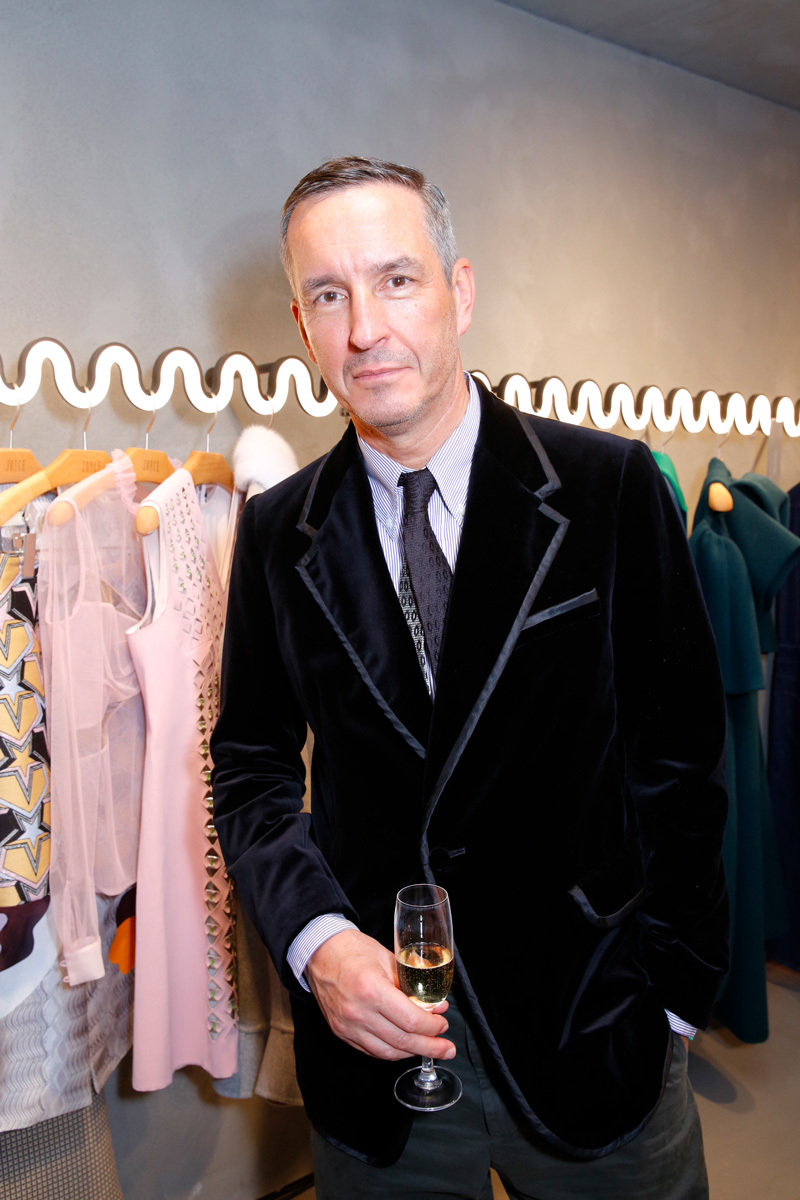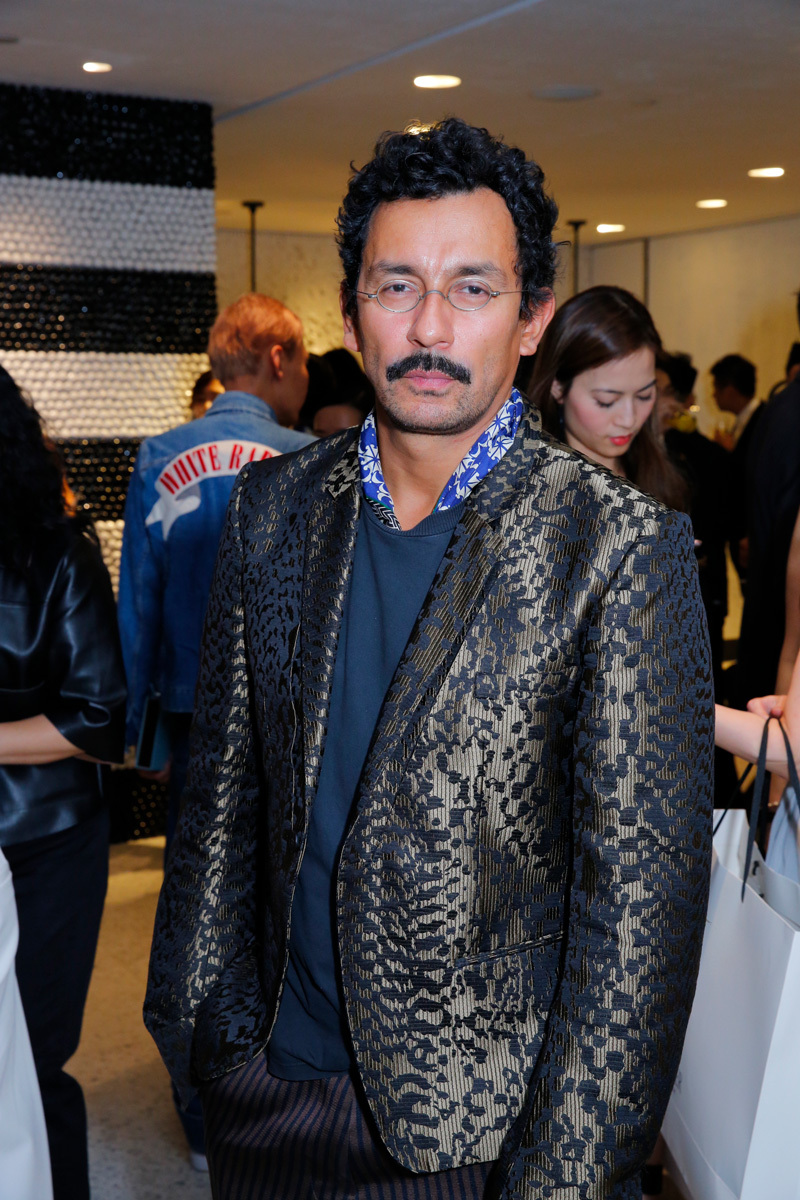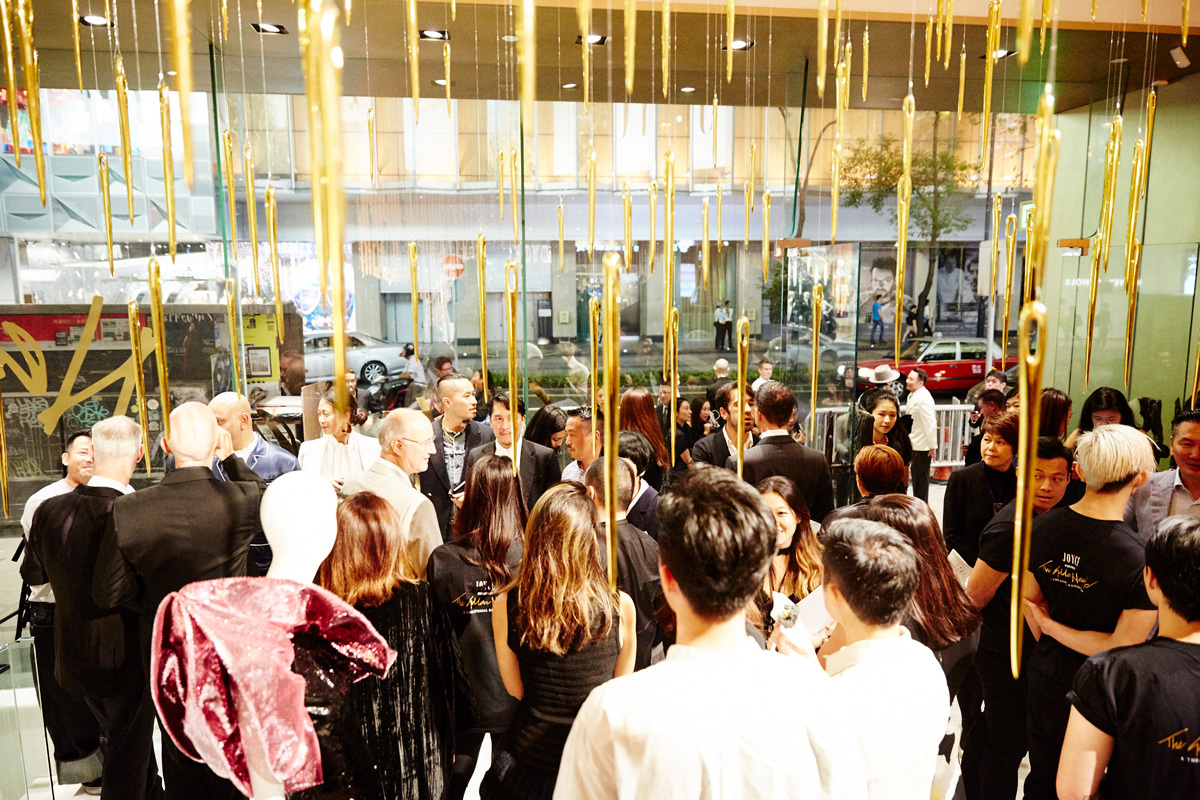Hovering like a halo over the Joyce Central store in Hong Kong, a Dries Van Noten campaign banner casts its golden light down the street. It’s something of an oxymoron for a designer, who has famously never advertised even if his company is rich enough to do so. Shot by the store to mark the re-launch of Joyce Central in the fall of 2016 — a sprawling interior expansion and makeover by architect Paola Navone — the campaign illuminates the retail haven in a giant testimony to the independent fashion brands championed by Joyce since the 70s, alongside powerhouses such as Prada and Yves Saint Laurent. The store itself is no longer independent. It was bought by the Lane Crawford empire in the early 2000s in a time when conglomerates were snapping up standalone fashion stores and brands like there was no tomorrow. Unlike some of the companies that were bought up back then, Joyce has retained its ethos of individuality: a devotion to creative and financial independence in fashion, more important now than ever in an industry that hires and fires creative directors before they’ve even made their mark.
“I’m so bored with ‘breaking news’,” Van Noten sighs over coffee at the Liang Yi Museum on an October morning in Hong Kong. “‘Designer fired!’ ‘New designer!’ ‘She’s going there, he’s leaving there!’ I’ve had it. It’s not even breaking news anymore. When it comes in every morning it has an impact on you. It gets you in a bad mood — a bad fashion mood.” The 58-year-old Belgian designer, currently celebrating the 30th anniversary of the house he founded in 1986, is in Hong Kong with Rick Owens, Haider Ackermann, and Courrèges designers Sebastien Meyer and Arnaud Vaillaint to celebrate the new Joyce Central. And you can’t help but notice a pattern in their troupe. Van Noten and Owens run the two most successful independent fashion brands in the world, while Ackermann and Courrèges are both owned by minor non-conglomerates. This is the face of fashion’s anti-establishment today — a perhaps unintended opposition to the big players but a contrast, nonetheless, to an industry largely ruled by a small group of major corporations. “More collections, more collections, more product,” Dries continues, summing up the state of the industry now.
“A lot of people are starting to see that it’s also about humans, and I think that’s part of the success of Rick’s and my brands, and also why Joyce is becoming more important,” he notes. “First it was all about mono-brand stores, but now people prefer to go back to smaller stores where the staff knows you and what piece you bought last season. At the moment, people are fascinated by things that have to do with skill and tradition, and are not copies of what they know.” It’s a rediscovered focus on craftsmanship — observed, for instance, in the rise of Alessandro Michele’s intricate Gucci — which has always been at the core of this store, founded by the illustrious Joyce Ma in 1970. She first stopped by Van Noten’s showroom in the late 80s. “She came in, said hello, went through the rails, and then, ‘Maybe too early. Maybe next season.’ And off she went.” The following season Ma bought his collection; a few years later she opened a standalone store for him in Hong Kong. “To be represented by Joyce immediately gave you a lot of credibility to the rest of the world, because she was one of the benchmarks,” Dries recalls.

“She is the last of a dying breed,” Rick Owens declares over dinner at Hong Kong’s Foxglove. “There were pioneers in the 90s, who would take big chances on designers and would make those designers. And there are very few of them left. It makes me wonder where those pioneers are now? These were mavericks, who invested their soul and money and integrity. Now there are conglomerates and it’s a different story. I don’t know people like that now.” In 2015, Joyce opened a standalone Hong Kong store for the 54-year-old designer — who founded his brand in 1994 — cementing its devotion to Owens, the perhaps most outspokenly independent designer profile in fashion. “We’ve always worked with designers that have a very distinctive aesthetic, and who have been true to their vision. It happens to be that these designers are the ones who have stayed independent, that have kept that creativity and that freedom, and that’s ultimately something that the Joyce customer really appreciates,” explains Andrew Keith, President of the Lane Crawford Joyce Group.
“In a world where there’s a lot of product and brand and movement of creative directorship, being small and having a focus on detail, and being dedicated to what you do, has real value to it now. The integrity of being true to yourself is now being realized as very valuable.” Keith says Joyce’s top client base will spend in excess of $380,000 a year on fashion, and it doesn’t all go into the powerhouse brands you might think. “The brands that are selling for us are the Ricks, the Drieses, the Haiders,” he notes. “In this part of the world you’ve had a really big shift in terms of an appreciation of fashion, so the customer has become much more sophisticated and much more aware of the fact that there are lot of very interesting independent brands out there, and that has become part of displaying your knowledge and kind of coolness. You discovered them, you know how to wear them. It gives you an insider positioning.” It’s also a development that goes hand-in-hand with the emergence of social media-fueled brands such as Vetements and Off-White, whose reverence of cult designers like Martin Margiela is enlightening a post-millennial audience about avant-garde fashion — past and present.
“It’s difficult to ask a Belgian designer that,” Dries smiles, faced with the question of those independently business-savvy Margiela worshippers. “I have respect for how clever they are. Sometimes, I think, it’s also a little bit too literal. But it’s interesting. It’s turning things around in a good way. There’s room for that. I’m happy these things are happening, and that we’re using new mediums to talk about what they make. It’s a clever take on fashion. Respect for that.” The house now called Maison Margiela — where Demna Gvasalia earned his designer stripes years before launching Vetements — was one of those brands sold to a major group, Only the Brave, in the early 2000s. After a few years, Margiela left the house amidst rumors of creative differences, creating a position that would eventually be filled by John Galliano in 2015. Before making his comeback after a public meltdown that led to LVMH firing him from Dior in 2011, Galliano sparked an industry debate when, in 2013, he described to Charlie Rose the overwhelming pressures and expectations a creative director faces designing under a conglomerate-owned powerhouse like Dior.

When Raf Simons left the same house in 2015 after just seven seasons citing similar pressures, the debate was reignited, fueled this year by Hedi Slimane’s departure from the Kering-owned Saint Laurent after just eight seasons there. This fall, Brioni — also a Kering brand — parted ways with its unorthodox creative director Justin O’Shea after just one season, while Peter Dundas left the Clessidra-owned Roberto Cavalli only three seasons into his tenure. The list goes on, painting a picture of a corporate industry where the creative language of a designer is no longer something that’s cultivated through seasons, but something that needs to be delivered in his or her first try — a ready-to-use package solution, if you like. In some cases it works, like the prolific Alessandro Michele, who appeared to have dreamed up the all-embracing vision he launched for Gucci in 2015 before anyone even knew his name.
While the conglomerates often become scapegoats for an industry under pressure, all you can really blame them for is living up to market demand. In an insatiable industry of consumers with the attention spans of a bored teenager, we pretty much only have ourselves to thank for creating a climate where over-worked and over-sold designers end up at the mercy of the system, with little creative freedom. It’s why profitable independents such as Dries Van Noten and Rick Owens must be the envy of every designer in fashion right now — and surely count themselves the luckiest men in the industry? “I realize I’m very lucky. And the luck is in having made a good marriage. I have a CEO and distribution partner, who are probably more talented than I am,” Rick says, referring to Eliza Lanzo and Luca Ruggeri, who own the only twenty percent of his company not controlled by Owens and his wife Michèle Lamy. “To have a force that executes your ideas without blinking and without any questions, that’s the miracle. I’m not the miracle, they are.”
Said marriage has enabled Owens to run a business largely funded by pre-collection sales, giving him the liberty to express himself freely and without commercial restraint in his show collections. Speaking backstage about his collection of evening gowns this September, he cheekily shrugged, “I don’t know how it’s gonna work in a store, but we’ll worry about that later.” At dinner in Hong Kong he elaborates: “I was being a little glib when I said that. The samples for the showroom were delicate, but I know how to make it more for production. It’s not going to be a problem. But I do have that flexibility where I can just fart out anything that I want, just on a whim, and know that I have the time and the power to make sure that when they get in the store, we’re fine.” In fact, the collection itself was a reflection on the state of the union. “I was reacting to what’s going on in fashion now: conservative and careful and commercial. The fact that I was doing things that were fragile and hard to produce and hard to ship and hard to show in a store, was an emotional reaction to the straight world we live in now.”

They’re poignant words in a spring/summer 17 season, which saw the first major push for see-now-buy-now fashion at Burberry, Tommy Hilfiger, Tom Ford, and Topshop Unique. “There’s definitely benefit for some customers in terms of having an immediate fix, but what we’re finding is that our customers are prepared to wait,” Andrew Keith says. “They want to see the show and know that they can buy it, but they appreciate the fact that it’s going to take a bit of time to actually manufacture that product, so they’re okay to wait. They just want to know that they can get it.” For Dries Van Noten, who has never given into as much as a pre-collection, surely nothing could be further from his ethics and principles on fashion than the idea of see-now-buy-now. He says the rediscovered taste he’s noticing in fashion for something less corporate and more personal is a contrary reaction to e-commerce itself.
“E-commerce is good for buying a cashmere sweater and some underwear, but for special outfits I don’t know. I think the internet is only selling pieces that look good on a small screen. That’s why certain brands do things with big stripes and bright colors — it’ll pop on the screen. But you can’t do microprint, because then the screen starts to flicker. Embroideries on blousons and bomber jackets are now always on the front, never on the back. Why not? Because that’s what you see on your screen. Fashion is really made, now, for that,” he shrugs. Don’t mistake his words for generation-based resistance — Van Noten does good business through the online retailers, and in place of the pre-collections he so deplores he famously offers buyers one of the biggest collections in the industry to buy from, way beyond what you see on the runway. It’s an area in which he and Rick Owens differ. “At the point of the women’s runway show we’ve already made all the money we need to make. We make most of the money we’re gonna make all season with our pre-collection orders, and that’s not a problem for me,” he says.

“I realize that the commercial is what goes out there and defines me — even more than a runway collection — and that’s fine with me because I’m proud of every little pre-collection piece that we make. This is not a compromise. I’m not making stuff that I don’t like or that I’m ashamed of. I’m making simple things that are made the way I want them to be. The runway clothes aren’t going to be on the floor very long before the sale. It’s a very small percentage of what I need to do to survive,” Rick explains. “So I can go bonkers. I can kind of do anything. And I should.” It’s not as if those collections become paintings for the blind. Early this season, Joyce took Thom Browne’s women’s runway collection — quite a showpiece-y affair — to Hong Kong for a few hours before it was off to Paris for the selling appointments. “This is runway Thom Browne, right?” Keith underscores. “I think they were absolutely astounded by the fact that we actually sold eighty pieces. But it also gives you an idea of the appetite that’s out there for real fashion and creativity. People wear it.”
It’s an appetite Van Noten has never doubted. Call up his stores in Antwerp, Paris, or Hong Kong after a show, and you can pretty much go on the waiting list for any showpiece you want — providing you can pay for it once it arrives. It’s a no-nonsense approach to an industry warped by the fact that major fashion brands often don’t put their most eye-catching runway pieces into production. Van Noten, however, says perceptions are changing. “I’m now old enough that I can share the wisdom I have with students. I like talking to young people, because often I’m surprised how clever they are and how right they are. In the past fashion students would ask me, ‘What can I do when someone is copying my clothes?’ My answer was, ‘You can be very happy because then you’re doing good work. If that’s your problem, look for another business.’ Now they’re really clever — they’re talking about how fashion is perceived,” he says and smiles. “I have good hopes for fashion.”
Credits
Text Anders Christian Madsen
